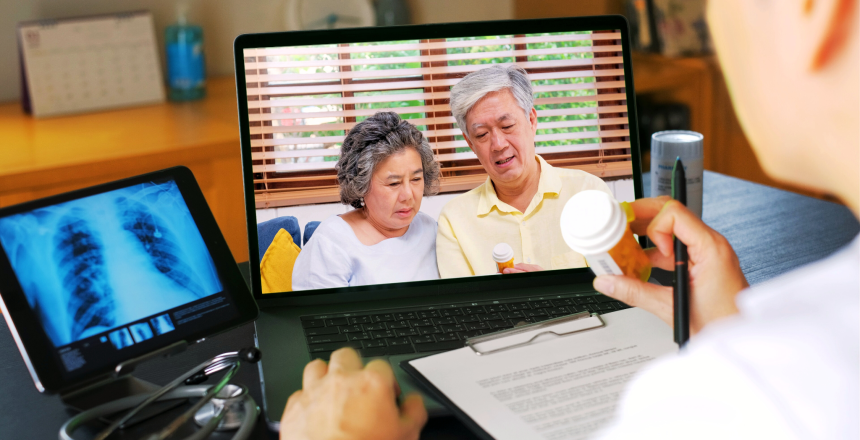The Rise of Digital Healthcare
Digital healthcare – what’s happening and how viable is it? Well, as we all know, the COVID19 pandemic pushed us all indoors and since then, some aspects have stuck. When we couldn’t go into doctors’ offices, we used the power of technology to connect us with healthcare professionals, and some of us are still doing so. But how far has digital healthcare come? and where could it lead us?
Telehealth
Telehealth refers to the delivery of health via technologies and the former comes from a hospital or clinic. It includes services that are enabled by non-medical equipment.
Telehealth can be split into three segments:
- Remote patient monitoring
- Telemedicine
- Kiosks
Remote patient monitoring involves monitoring a patient’s condition and vitals and feeding this data to a clinician. Prior to the pandemic, the number of remotely monitored patients was estimated to be over three million in 2020, with half being in the U.S. As of December 2021, this figure for remote monitoring solutions was 6.2 million patients. Remote monitoring is intended to improve patient care, shorten hospital stays and reduce readmissions.
Telemedicine is the use of telecommunications with information technology to provide clinical care not face-to-face. As such, it can occur in real time and often comes in the form of video or telephone consultations. It appears to be gaining ground in: USA, Canada, Europe-Middle East-Africa agglomeration (EMEA), Saudi Arabia, Japan and China.
The third aspect is kiosks. Health stations can be established in retail environments, clinics and workplaces. These broaden clinical capabilities for supporting those with acute medical problems or chronic conditions like hypertension, diabetes and obesity.
Telecommunications
Just as telemedicine is gaining ground, telecommunications operators are also looking to expand, with many interested in better positioning themselves in healthcare. At the moment, most still provide B2B services of network and connectivity.
Telecommunications can also make use of 5G and allow:
- Access to diagnostic data in real time
- Massive medical imaging files like MRIs and CT scans to be transferred quickly
- Accelerated use of analytics and AI in multi-access edge computing
As a result, they play a central role in rolling out remote care services, providing data exchange, transaction processing, authentication—all needed for telehealth.
Demand
The pandemic required an increased use of virtual care, which was very beneficial at the time. Initial demand for digital health was pushed by social distancing and the need for alternatives to in-person meetings. As such, the NHS reported that around 85% of their consultations were conducted remotely, at the pandemic’s peak.
The Lancet commented that the pandemic places a great deal of pressure on healthcare systems, but that it also was responsible for speeding up the development of digital healthcare. This acceleration appears to reflect a global demand increase for healthcare accessibility. At the forefront of supplying this demand is medtech. Accenture states that these companies have a specific understanding of providers, patients and therapeutics and so are in the best position to lead the digital trend.
Add to the initial need for digital healthcare, there is also a consumer want for it. In the age of “instant” consumers – patients – may expect more immediate care. One way of managing this is by using telehealth methods. This could be particularly useful in reducing waiting times. For instance, the U.K’s NHS had nearly 7.21 million people awaiting treatment in October 2022.
The benefits
The benefits that telehealth offers certainly warrants its demand. According to a recent article by Forbes, these benefits cover:
- Expanding healthcare access for people in rural areas, with mobility issues and with limited free time
- Save time for the physician and the patient
- More accurate monitoring
- Easier management of chronic conditions
- Better quality of care
- Less expensive costs
- More effective mental healthcare
Chronic diseases, such as diabetes, cancer, heart diseases, and asthma can all be managed using remote patient monitoring—which ensures consistent care for those with the illnesses. In the same vein, telehealth can provide a higher quality of care. According to JAMA Network, patients who are treated using telehealth have better outcomes (physical and mental) than those who go through conventional treatment.
Lastly, from a commercial perspective, telemedicine can cost less than conventional care. Software Advice conducted a study and observed that telemedicine was used by 70% of patients during the pandemic. Of these, 60% said that they actually preferred these consultations when ill with COVID-19. And since then, 62% of respondents have said that they favor remote appointments when they are available.
Going forward
Given its demand and benefits, telehealth is here to stay. In fact, the NHS recently announced their plan for digital health going forward. They plan to make the NHS app the ‘front door to NHS services’, injecting £2 billion to support all NHS trusts creating electronic patient records.
How else will telehealth actually expand? Vamstar might just be the answer. Our exchange database can help provide buyers with valuable telehealth technology, as it emerges. It connects healthcare buyers with suppliers, using artificial intelligence to create the best matches and most successfully fulfill tenders. Utilizing value-based procurement (VBP), we can ensure that all aspects of contracts are met, including non-price criteria—like most effectively using resources. For instance, telehealth can reduce unnecessary hospital visits by enabling consistent monitoring, this means that hospital resources are available for other uses. As such, we can support and effectively contribute to the expansion of digital health, benefitting healthcare as a whole.
COVID-19 | Digital Healthcare | NHS | Telehealth | Medicine | Telemedicine | Artificial Intelligence | Buyers | Suppliers | Supply Chain | Patient Care

